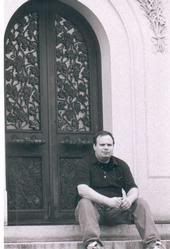THE BEYOND, Lucio Fulci's 1981 installment of his unofficial zombie cycle, is considered by many to be the director's masterwork, though as I've noted here before, it's always left me cold; I've always felt it was overrated, shadowing ZOMBIE or CITY OF THE LIVING DEAD as his definite work. In re-watching THE BEYOND for this blog, I'm pleased to say I finally recognized its significant merits, even if I'm not 100% sure it's the jewel in Fulci's crown.
It's certainly the most visually striking of his films, the sepia-tinted prologue quite possibly the stylistic highlight of Fulci's career. The sequence itself is one of his best regarded, if not for the creative display of violence levied against the artist Schweik, for its continuation of the Lovecraftian undertones lying within the painting that frames the plot. (The voice-over quotation, "And you shall face the sea of darkness, and all therein that may be explored," implies the same sort of cosmic terror that the man from Providence so frequently wrote about.)
Like a lot of cult movies, THE BEYOND isn't necessarily a great film as a whole, but features enough powerful individual moments to make it worthwhile. The initial build-up seems to be a string of such scenes, held together by a strong visual fabric, but when the film reaches David Warbeck's morgue it begins to fall apart. The first morgue scene is not only filled with incessantly improbable moments--hooking a cadaver to monitor brainwaves, a "Do Not Entry" sign, not to mention the acid jar that spews its contents by its own volition--but the manner in which they're crassly handled turns THE BEYOND into an average gratuitous-gore flick; the infamous library sequence, wherein Michele Mirabella falls prey to a swarming cluster of tarantulas, is another example of this misstep. The film works best as a garishly-lit ghost story, and when these admittedly bravura but tonally inconsistent segments occur they become literal show-stoppers, taking the audience out of the story to marvel over the crudity of their special effects (which, especially in the case of the flesh-eating tarantulas, can be laughably poor).
Fulci's often been accused of ripping off Dario Argento--and having a blind girl getting her throat torn out by her seeing-eye dog doesn't exactly let him off the hook here--but some of THE BEYOND's weakest moments happen when he imitates himself. There's an attempt to recreate ZOMBIE's notorious eye-splinter scene (a woman has her head impaled upon a nail, which pushes its way out her eye socket) that packs nowhere near the punch as its predecessor; even the finale as Warbeck and Catriona MacColl stand off against zombies in the morgue feels like an elaborate version of ZOMBIE's hospital showdown. Even the plot itself--MacColl's hotel rests above one of the seven gateways to Hell--is uncomfortably close to CITY, and not quite as a further exploration of its theme.
Quibbling about imitation in Italian horror films, though, is like griping about the humidity in Florida--it comes with the territory; Fulci still manages to pull off quite a few remarkable bits on his own. The final shot of the hotel is a superbly understated moment as silhouettes slowly fill in the windows, supporting Fulci's claim that Jacques Tourneur was THE BEYOND's primary influence. There's also the somewhat ambiguous ending that compliments the dream-like logic that propels so many of his best films. (Personally, I think it's Fulci's best-realized denouement ever.)
Throw in Fabio Frizzi's evocative score--again, one of Fulci's most effective soundtracks--and you've got a film that skirts the line between art and exploitation, that hard-to-find sweet spot that makes low-budget fright films so satisfying. THE BEYOND is essential Italian horror; I'm glad I finally saw the light.
Thursday, May 22, 2008
Subscribe to:
Post Comments (Atom)

No comments:
Post a Comment